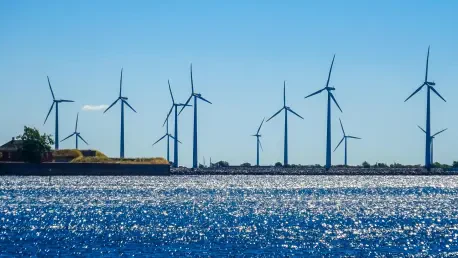As the battle over renewable energy intensifies, a significant clash has emerged between the Trump administration and the offshore wind industry, with the SouthCoast Wind project off the Massachusetts coast caught in the crosshairs. This ambitious initiative, poised to generate substantial clean energy, faces an uncertain future due to a systematic push against wind power from federal authorities. Recent actions, including permit reconsiderations and broader policy shifts, signal a determined effort to halt progress in this sector. The implications of this conflict extend beyond a single project, raising questions about the trajectory of renewable energy in the United States. With legal battles brewing and state leaders pushing back, the struggle over SouthCoast Wind encapsulates a larger debate about balancing environmental goals with political agendas. This unfolding story reveals deep divisions in energy policy and the challenges of transitioning to sustainable power sources amid opposition at the highest levels of government.
Federal Pushback on Offshore Wind Initiatives
The Trump administration has launched a comprehensive campaign to dismantle offshore wind development, with SouthCoast Wind emerging as a primary target. A court filing from the Department of the Interior, handled through the Department of Justice, disclosed plans to reevaluate permits issued just months ago for this project, which ranks as the nation’s 11th commercial-scale offshore wind endeavor. Located south of Martha’s Vineyard and Nantucket, the project, developed by Ocean Wind North America, aims to produce up to 2,400 MW of power using as many as 141 turbines. However, the federal move to reconsider approvals aligns with broader directives, including stop-work orders and freezes on new permits, reflecting a clear intent to obstruct the industry. This policy shift also includes withdrawing tax credits and funding grants, further threatening the financial viability of projects like SouthCoast Wind. The administration’s actions suggest a sweeping rollback of renewable energy initiatives, prioritizing opposition to wind power over environmental commitments.
Beyond SouthCoast Wind, the administration’s strategy encompasses multiple fronts to hinder offshore wind progress across the country. Executive orders have mandated industry-wide reviews, citing national security concerns as justification for intensified scrutiny. Projects such as Empire Wind in New York and Resolution Wind in Massachusetts, the latter of which is 80% installed, have been halted as part of this aggressive stance. Additionally, the withdrawal of grants for port infrastructure critical to supporting the industry signals a deeper policy pivot away from renewables. This systematic approach has created a chilling effect, stalling momentum for clean energy development at a time when climate goals are more urgent than ever. The targeting of SouthCoast Wind is not an isolated incident but part of a broader pattern aimed at dismantling the offshore wind sector, raising alarms among advocates who see these projects as vital to reducing carbon emissions and fostering sustainable energy independence.
Local Resistance and Legal Challenges
While federal opposition poses a significant threat, local resistance adds another layer of complexity to the SouthCoast Wind project’s future. The Town of Nantucket has initiated legal action, challenging the permitting process overseen by the Bureau of Ocean Energy Management (BOEM). The lawsuit contends that the process failed to adequately address environmental harm, arguing that insufficient mitigation measures set a troubling precedent for bypassing critical safeguards. Nantucket’s concerns reflect a broader unease among some local stakeholders about the proliferation of wind turbines, with up to 743 potentially dotting nine designated sites near the island. Although framed as a defense of environmental and preservation laws, this opposition contributes to the growing resistance against offshore wind development in the region. The clash between local priorities and national energy objectives underscores the difficulty of implementing large-scale renewable projects in areas with competing interests.
In response to federal and local challenges, developers of SouthCoast Wind have pushed back against the government’s reconsideration efforts, viewing them as part of a blanket policy to eliminate offshore wind initiatives regardless of specific impacts. Meanwhile, a coalition of governors from five states—Connecticut, Massachusetts, New Jersey, New York, and Rhode Island—issued a joint statement urging the administration to respect existing permits. This collective stance, coupled with litigation challenging the executive order, highlights significant political pushback against the federal agenda. The legal battles surrounding SouthCoast Wind illustrate a polarized landscape where state leaders and project proponents advocate for the continuation of renewable energy projects deemed essential to meeting climate targets. This multifaceted conflict reveals the tension between localized environmental concerns and the broader imperative to advance clean energy, with the project’s fate hanging in the balance amid ongoing disputes.
Navigating the Future of Renewable Energy
Looking ahead, the struggle over SouthCoast Wind serves as a microcosm of the broader challenges facing offshore wind energy in the United States. The Trump administration’s concerted efforts to obstruct this sector through permit reevaluations, funding cuts, and industry reviews have created a hostile environment for renewable projects. Yet, the resistance from state leaders and developers signals a determination to preserve progress toward sustainable energy goals. The outcome of legal challenges and policy disputes will likely shape the trajectory of not only SouthCoast Wind but also the entire offshore wind industry. As these battles unfold, stakeholders must navigate a complex interplay of federal mandates, local opposition, and environmental priorities, seeking pathways to reconcile differing interests for the greater good of clean energy advancement.
Reflecting on the events that transpired, it became evident that the clash over SouthCoast Wind had set a precedent for how renewable energy projects could be contested on multiple fronts. The federal rollback of permits and funding, coupled with local lawsuits, had tested the resilience of the offshore wind sector. Moving forward, a balanced approach was needed—one that addressed legitimate environmental concerns while safeguarding the momentum of clean energy initiatives. Collaborative efforts between state governments, developers, and communities emerged as a potential solution to bridge divides. Additionally, advocating for transparent permitting processes and robust mitigation strategies offered a way to rebuild trust among stakeholders. The lessons learned from this conflict pointed to the importance of dialogue and compromise in ensuring that the push for sustainability did not falter under political or regional pressures, paving the way for a more inclusive energy future.









